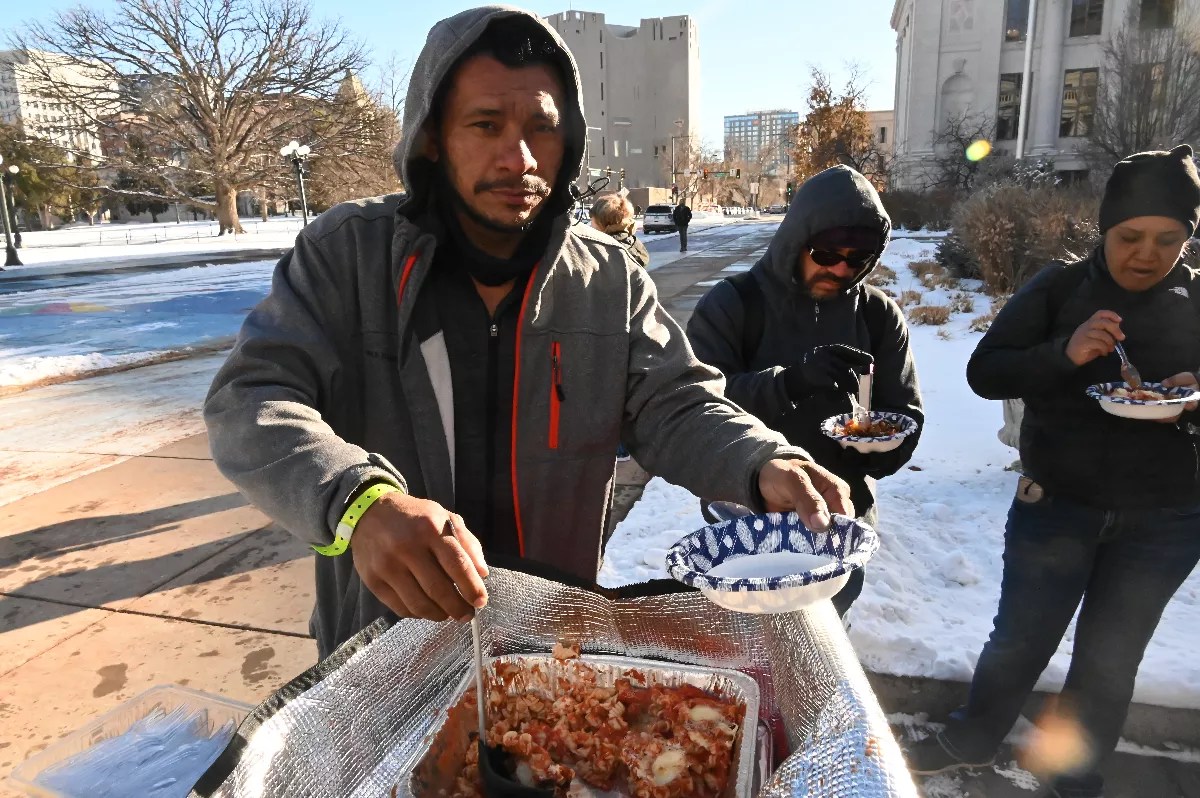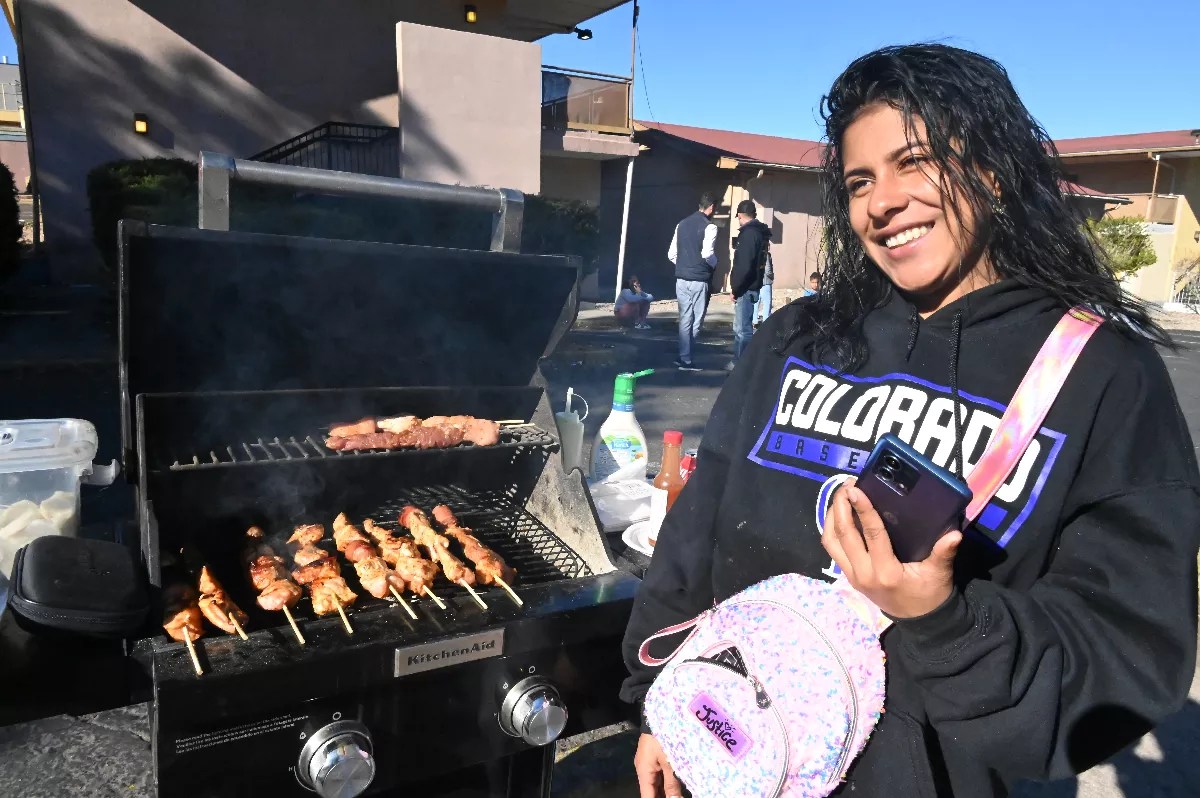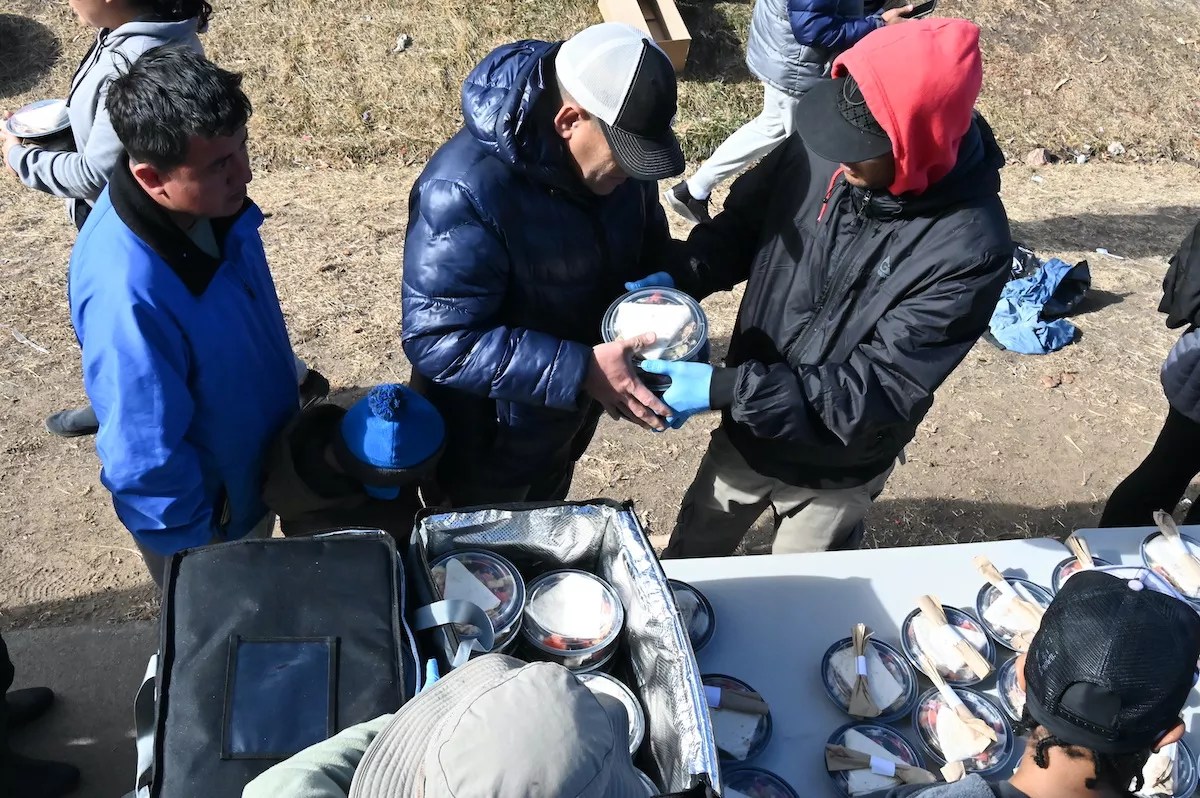
Bennito L. Kelty

Audio By Carbonatix
A spoonful of salsa or green chile can bring Mexican dishes to life in Colorado. But a spicy sauce can also ruin the appetite of a Venezuelan migrant.
Donations of spicy Mexican food aren’t sitting right with the stomachs of Venezuelan migrants, many of whom rely on free food while they wait for a chance to work.
As a member of Headwater Protectors, a group that brings clean water to homeless encampments and picks up trash, Hilda Nucete often visits migrants living on the street, and she says many of them feel bad about being unable to eat the spicy food donated to them and not wanting to waste it.
“We’re actually hearing from folks in the encampments saying, ‘We don’t like it,'” Nucete says. “Normally, they don’t eat red chile or food that’s quite spicy, or things that are smothered.”
The problem stems from “thinking immigrant people are like a monolith,” she adds. “People might think just because you’re a migrant, you most likely eat Mexican food – or just because you’re Latino, you eat spicy food.”
Antony Romero, a Colombian migrant, says that most of the spicy dishes are coming from local Mexican immigrants, not Americans, who tend to donate “more pizza, chicken.” Mexican immigrants have been active supporters of Venezuelan migrants, according to Nucete, calling them “bilingual immigrants who are really excited to be a part of this process.”
Angel Jose Guillermo Velazquez, a Venezuelan migrant living in Denver, says that spicy food causes problems for his digestive system, but he forces himself to eat free dishes out of appreciation. The spicy donations are often Mexican dishes, and Velazquez says he just can’t handle the country’s cuisine.
“That’s their style, and I respect it,” Velazquez says. “For me, I don’t like spicy food a lot, but if it’s served to me in any way, I have to eat it.”
Nucete is also on the board of Papagayo, one of the principal nonprofits helping the City of Denver get housing and work for migrants, and she has been the co-chair of the Colorado Health Equity Commission since 2021. A Venezuelan native who came to the United States in 2007, she’s recommending that Denver residents cut back on donating spicy dishes.
Facebook posts have called “for people if they wanted to make burritos or quesadillas or bring enchiladas and tamales,” Nucete says. One Denver resident donated “boxes and boxes” of spicy Cheetos to a migrant encampment, Nucete recalls, “and nobody wanted to eat them. ‘They’re really spicy to us, and we’re just afraid they’re going to waste,'” she says migrants have told her.
“It’s very rare, a Latino person who eats spicy food in Venezuela,” says migrant Adriani Colina of her home country. “But it’s very good, Mexican food. It’s just spicy.”
Most migrant encampments don’t have porta-potties, Nucete points out, and “if you have spicy food and people who are not used to spicy food or refried beans – because we actually eat black beans, and they’re more solid – your bowel movements are going to be completely different.”
In Search of Traditional Venezuelan Dishes
Often the favorite and “most traditional plate” for Venezuelans, Nucete adds, is the arepa, which is corn dough stuffed with meat and other fried items like cheese and potatoes. They’re easy to make and can take a variety of ingredients; Nucete remembers eating arepas as a kid with just butter and sugar when there was nothing else to add.

Stefanny Taveras cooks pinchos outside of a migrant shelter.
Bennito L. Kelty
Outside of the last non-congregate migrant shelter in Denver, Romero sells what he calls “big arepas” for $5 each, mostly to Venezuelan migrants. He agrees that South American migrants have problems with Mexican food donated to them in Denver and while walking across Mexico on their way north.
“A lot of chile, a lot of heat, it doesn’t sit well with us,” Romero says. “Mexican food is really good, but the only thing is it has a lot of chile and it burns, it burns too much. Not all of us eat hot food.”
Romero migrated to Denver about a year ago, walking from Chile. Unlike many Venezuelan migrants in Denver, he’s able to work and live in a place he rents. Selling arepas was a sure way to make extra money because he knew other South American migrants missed their home fare.
“The arepa is something Venezuelans and Colombians eat a lot, but more so the Venezuelans,” Romero explains. “I walked through twelve countries, and the whole way, we didn’t see rice. We just saw tacos and tortilla, so when we came here, we sold arepa because one’s far from their country here.”
Romero isn’t alone. Other Venezuelan migrants who have timed out of the city’s shelters return and set up tables or grills right next to him, including Colina, who sells pineapple juice for $2 a cup.
Stefanny Tavera came to Denver from Venezuela four months ago and has already timed out of the city’s migrant shelters. Now she’s staying with a friend, but she returns to her former shelter with a KitchenAid propane grill so she can sell pinchos, or small cuts of meat skewed together like shish kebab.
Tavera’s pinchos come with four or five chunks of seasoned chicken and sausage, and she sells two for $5. For anyone who wants to top off the meat, she keeps ranch dressing, mayo and hot sauce nearby. Venezuelans like spicy food, “but only very little,” Tavera admits. “Not like Mexicans. Mexicans eat so much spicy food.”
For Venezuelan migrants, Mexico was the longest leg of their walk to the United States, and that experience left them with a bad taste in their mouths for one dish in particular: tacos.
“Everything was taco, taco, taco, taco, taco,” Tavera says. “I got to the point where I was like, ‘No more, no!’ We’re not very in love with the taco, us Venezuelans.”
Romero started selling small arepas to other migrants on the walk through Mexico “because every day it was tacos,” he says.
The Venezuelan and Mexican palates do overlap, though, Nucete notes. Mexican rice, which is usually seasoned with cumin and garlic and cooked in tomato sauce, is “pretty similar” to what Venezuelans eat. Likewise, menudo, which isn’t spicy but has hominy stewed in red chile and cow stomach broth, is also “something that people would enjoy,” Nucete says.

Migrants pick up lunch outside their shelter in Montbello.
Bennito L. Kelty
“I like to eat rice,” Romero says. “With beans, with meat, with chicharrón,” or deep-fried pork skin, which is also popular in Mexico.
Colina says she likes “rice, pasta, chicken, meat, salad.”
“The normal food from my Venezuela is chicken with rice and some potatoes,” Velazquez says. The chicken is usually lightly breaded, he adds, and cooked with “oil, fry the chicken, salt and wheat flour, and you can add an egg, too.”
“Simple meats, anything like ham, is pretty popular too,” Nucete says. “There’s so many simple Latin American recipes like arroz con pollo that can be done, even simple soups or sancochos [stews], especially in the wintertime.”
Black beans are preferred to refried beans, Nucete notes, along with white rice, plantains and shredded beef. Those are also the four typical ingredients for the national dish of Venezuela, pabellón criollo.
Food at the City Migrant Shelters
Denver City Council has committed to feeding migrants for the next three months after approving two vending contracts worth $850,000 on Monday, April 1. This pays for three months’ worth of meals for the migrants at shelters, according to the city. So far, Denver has spent around $3 million to feed migrants at its shelters, and it has spent more than $63 million in total on services for migrants, including meals, beds and onward travel.
Adults in migrant shelters get two free meals a day: breakfast and dinner. Children are served lunch, too. Shelters also offer snacks like trail mix, granola bars, string cheese, crackers and fruit, along with water bottles and cans of soda.
Migrants say that the meals at shelters are dishes like chicken or burgers. They’ve also complained that shelters don’t offer enough to eat, and that they can’t bring in their own fresh food or meals purchased elsewhere.
“I would question how [nutritious] the dishes are,” Nucete says. “I have already seen a lot of burgers and things like that.”
Despite the spicy donations, Romero says that migrants from Venezuela or Colombia appreciate the gesture, even if they can’t handle the heat.
“Thankful, always, for the little and the lot. We’re always thankful for the food,” Romero adds. “Bring what you bring. We’re never going to turn it down. We’re very grateful for everything from the people who have taken care of us.”